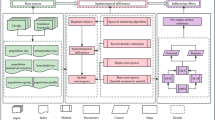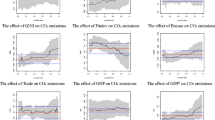Abstract
The challenge of reducing emissions of greenhouse gases (GHG) has stimulated great attention among policymakers and scholars in recent past, and a number of STIRPAT (Stochastic Impacts by Regression on Population, Affluence, and Technology) studies on carbon emissions have been conducted. This paper contributes to that literature by: (i) studying per capita GHG emissions in the United States (US) adopting STIRPAT modeling framework; (ii) employing new explanatory factors like cattle population density, political willingness to address environmental problems, and educational attainment; and (iii) investigating whether emissions elasticities of various factors vary within the US or not. State-level panel data over the period 1990–2014 are used, and partitioning of the sample is done with respect to two controlling factors: an indicator of political support to environmentalism and educational attainment. Results of heterogeneous slope parameters panel data models indicate that cattle density and affluence are major drivers of per capita GHG emissions in the continental US. We find strong evidence of heterogeneity in emissions elasticities across partitioned samples. Our grouping analysis suggests that in a diverse country like US, policymakers should not focus on the average relationships dictated by a single STIRPAT equation, but should account for regional differences if they want accuracy and higher effectiveness in climate policymaking.




Similar content being viewed by others
Notes
List of ten states: Oklahoma, Rhode Island, Illinois, Arkansas, Missouri, South Dakota, Mississippi, Iowa, Nebraska, and North Dakota.
Ehrlich and Holdren (1971) introduced a mathematical identity I ≡ PAT (I: environmental impact; P: population; A: affluence; T: technology) which has been used as a modeling framework for analyzing the main drivers of anthropogenic environmental impacts. In 1990s, scholars reformulated IPAT model to its stochastic cousin named STIRPAT which allows both hypothesis testing as well as relaxes the implicit assumption of proportionality to conduct empirical research.
Heating degree days (HDD) and cooling degree days (CDD) are used in calculations pertaining to building energy consumption (US Energy Information Administration 2012).
We call a state ‘Strongly Republican’ if the state is carried by the Republican Party in at least three of the four presidential elections (years: 2000, 2004, 2008, 2012).
Details of Median test results are as follows. Results from environmentalism-based partition: (a) Year = 1990, χ2(1) = 6.4; Probability > χ2 = 0.01; (b) Year = 2014, χ2(1) = 6.4; Probability > χ2 = 0.01. Results from educational attainment-based partition: (a) Year = 1990, χ2(1) = 3.6, Probability > χ2 = 0.05; (b) Year = 2014, χ2(1) = 6.4, Probability > χ2 = 0.01.
EERS emphasizes on long-term energy savings target by achieving certain percentage reduction in the total energy sales from energy efficiency measures. RPS requires that electric utilities are supposed to produce certain percentage of the total electricity generated from renewable sources. Interested reader may refer to Carley and Browne (2013) for details.
References
Aldy, J. E. (2005). An environmental Kuznets curve analysis of US state-level carbon dioxide emissions. The Journal of Environment & Development,14(1), 48–72.
Auffhammer, M., & Steinhauser, R. (2007). The future trajectory of us CO2 emissions: The role of state versus aggregate information. Journal of Regional Science,47(1), 47–61.
Boden, T. A., Marland, G., & Andres, R. J. (2015). National CO2 emissions from fossil-fuel burning, cement manufacture, and gas flaring: 1751–2011, Carbon Dioxide Information Analysis Center, Oak Ridge National Laboratory, US Department of Energy. https://doi.org/10.3334/cdiac/00001_v2015.
Brulle, R. J., Carmichael, J., & Jenkins, J. C. (2012). Shifting public opinion on climate change: an empirical assessment of factors influencing concern over climate change in the US, 2002–2010. Climatic Change,114(2), 169–188.
Carley, S., & Browne, T. R. (2013). Innovative US energy policy: A review of states’ policy experiences. Wiley Interdisciplinary Reviews: Energy and Environment,2(5), 488–506.
Clement, M. T., & Elliott J. R. (2012). Growth machines and carbon emissions: A county-level analysis of how US place-making contributes to global climate change. In G. H. William (Ed.) Urban areas and global climate change (research in urban sociology, vol. 12), Emerald Group Publishing Limited, pp 29–50.
Dietz, T., Frank, K. A., Whitley, C. T., Kelly, J., & Kelly, R. (2015). Political influences on greenhouse gas emissions from US states. Proceedings of the National Academy of Sciences,112(27), 8254–8259.
Dietz, T., & Rosa, E. A. (1997). Effects of population and affluence on CO2 emissions. Proceedings of the National Academy of Sciences USA,94(1), 175–179.
Eberhardt, M. (2012). Estimating panel time-series models with heterogeneous slopes. The Stata Journal,12(1), 61–71.
Eberhardt, M., & Bond, S. (2009). Cross-section dependence in nonstationary panel models: A novel estimator. MPRA Paper 17692, University Library of Munich. http://mpra.ub.uni-muenchen.de/17692/1/MPRA paper 17692.pdf.
Eberhardt, M., & Teal, F. (2010). Productivity analysis in global manufacturing production. Discussion Paper 515, Department of Economics, University of Oxford. http://www.economics.ox.ac.uk/research/WP/pdf/paper515.pdf.
Ehrlich, P. R., & Holdren, J. P. (1971). Impact of population growth. Science, New Series,171(3977), 1212–1217.
Fan, Y., Liu, L.-C., Wu, G., & Wei, Y.-M. (2006). Analyzing impact factors of CO2 emissions using the STIRPAT model. Environmental Impact Assessment Review,26, 377–395.
FAO (2013). FAO statistical yearbook 2013. Rome.
Food and Agriculture Organization of the United Nations (FAO). (2011). World Livestock 2011—livestock in food security. Rome.
Gerber, P. J., Steinfeld, H., Henderson, B., Mottet, A., Opio, C., Dijkman, J., et al. (2013). Tackling climate change through livestock: A global assessment of emissions and mitigation opportunities. Rome: FAO.
Gilmore, E. A., & St. Clair, T. (2017). Budgeting for climate change: obstacles and opportunities at the US state level. Climate Policy. https://doi.org/10.1080/14693062.2017.1366891
Itkonen, J. V. (2012). Problems estimating the carbon Kuznets curve. Energy,39(1), 274–280.
Jaforullah, M., & King, A. (2017). The econometric consequences of an energy consumption variable in a model of CO2 emissions. Energy Economics,63, 84–91.
Jorgenson, A. (2006). Global warming and the neglected greenhouse gas: A cross-national study of the social causes of methane emissions intensity, 1995. Social Forces,84(3), 1779–1798.
Jorgenson, A. K., Schor, J. B., Huang, X., & Fitzgerald, J. (2016). Income inequality and residential carbon emissions in the United States: A preliminary analysis. Human Ecology Review,22(1), 93–105.
League of Conservation Voters (LCV). Scorecards retrieved from: http://scorecard.lcv.org/
Liddle, B. (2015). What are the carbon emissions elasticities for income and population? Bridging STIRPAT and EKC via robust heterogeneous panel estimates. Global Environmental Change,31, 62–73.
Liddle, B., & Lung, S. (2010). Age-structure, urbanization, and climate change in developed countries: revisiting STIRPAT for disaggregated population and consumption-related environmental impacts. Population and Environment,31(5), 317–343.
Marcotullio, P. J., Sarzynski, A., Albrecht, J., Schulz, N., & Garcia, J. (2013). The geography of global urban greenhouse gas emissions: An exploratory analysis. Climatic Change,121(4), 621–634.
Mather, M., Jacobsen, L. A., & Pollard, K. M. (2015). Aging in the United States. Population Bulletin,70(2), 1–18.
McDermott, M. (2009). Know your energy: The 5 states that supply 73% of US coal. Retrieved from: https://www.treehugger.com/corporate-responsibility/know-your-energy-the-5-states-that-supply-73-of-us-coal.html
Menz, T., & Welsch, H. (2012). Population aging and carbon emissions in OECD countries: Accounting for life-cycle and cohort effects. Energy Economics,34, 842–849.
O’Neill, B. C., Liddle, B., Jiang, L., Smith, K. R., Pachauri, S., Dalton, M., et al. (2012). Demographic change and carbon dioxide emissions. Lancet,380, 157–164.
Pesaran, M. H., & Smith, R. (1995). Estimating long-run relationships from dynamic heterogeneous panels. Journal of Econometrics,68(1), 79–113.
Progressive Dairyman. (2017). 2016 US dairy statistics. Retrieved from: https://www.progressivedairy.com/site/stats/us-dairy-stats
Ripple, W. J., Smith, P., Haberl, H., Montzka, S. A., McAlpine, C., & Boucher, D. H. (2014). Ruminants, climate change and climate policy. Nature Climate Change,4(1), 2–5.
Roberts, T. D. (2011). Applying the STIRPAT model in a post-Fordist landscape: Can a traditional econometric model work at the local level? Applied Geography,31(2), 731–739.
Sadorsky, P. (2014). The effect of urbanization on CO2 emissions in emerging economies. Energy Economics,41, 147–153.
Shafiei, S., & Salim, R. A. (2014). Non–renewable and renewable energy consumption and CO2 emissions in OECD countries: A comparative analysis. Energy Policy,66, 547–556.
Sivak, M. (2008). Where to live in the United States: combined energy demand for heating and cooling in the 50 largest metropolitan areas. Cities,25(6), 396–398.
Squalli, J. (2017). Renewable energy, coal as a baseload power source, and greenhouse gas emissions: Evidence from US state-level data. Energy, 127, 479–488.
Turner, A. J., Jacob, D. J., Benmergui, J., Wofsy, S. C., Maasakkers, J. D., Butz, A., et al. (2016). A large increase in US methane emissions over the past decade inferred from satellite data and surface observations. Geophysical Research Letters,43(5), 2218–2224.
US Department of State. (2014). United States climate action report 2014. Retrieved from: https://www.globalchange.gov/browse/reports/us-climate-action-report-2014
US Energy Information Administration. (2012). Annual energy review 2011. Retrieved from: https://www.eia.gov/totalenergy/data/annual/pdf/aer.pdf
US Environmental Protection Agency. (2016). Inventory of US Greenhouse Gas Emissions and Sinks: 1990–2014. Retrieved from: https://www.epa.gov/ghgemissions/inventory-us-greenhouse-gas-emissions-and-sinks-1990-2014
Videras, J. (2014). Exploring spatial patterns of carbon emissions in the USA: A geographically weighted regression approach. Population and Environment,36(2), 137–154.
Wei, T. (2011). What STIRPAT tells about effects of population and affluence on the environment? Ecological Economics,72, 70–74.
World Resources Institute. (2017). Retrieved from: http://www.wri.org/resources/data-sets/cait-country-greenhouse-gas-emissions-data
York, R., Rosa, E. A., & Dietz, T. (2003a). a. A rift in modernity? Assessing the anthropogenic sources of global climate change with the STIRPAT model. International Journal of Sociology and Social policy,23(10), 31–51.
York, R., Rosa, E. A., & Dietz, T. (2003b). b. STIRPAT, IPAT and ImPACT: Analytic tools for unpacking the driving forces of environmental impacts. Ecological Economics,46(3), 351–365.
Zagheni, E. (2011). The leverage of demographic dynamics on carbon dioxide emissions: Does age structure matter? Demography,48(1), 371–399.
Zahran, S., Brody, S. D., Grover, H., & Vedlitz, A. (2006). Climate change vulnerability and policy support. Society and Natural Resources,19, 771–789.
Zhu, Q., & Peng, X. (2012). The impacts of population change on carbon emissions in China during 1978–2008. Environmental Impact Assessment Review,36, 1–8.
Acknowledgements
We are immensely grateful to two anonymous referees for valuable comments and suggestions on the earlier version of this article. Remaining errors, if any, are our own.
Author information
Authors and Affiliations
Corresponding author
Rights and permissions
About this article
Cite this article
Singh, M.K., Mukherjee, D. Drivers of greenhouse gas emissions in the United States: revisiting STIRPAT model. Environ Dev Sustain 21, 3015–3031 (2019). https://doi.org/10.1007/s10668-018-0178-z
Received:
Accepted:
Published:
Issue Date:
DOI: https://doi.org/10.1007/s10668-018-0178-z




